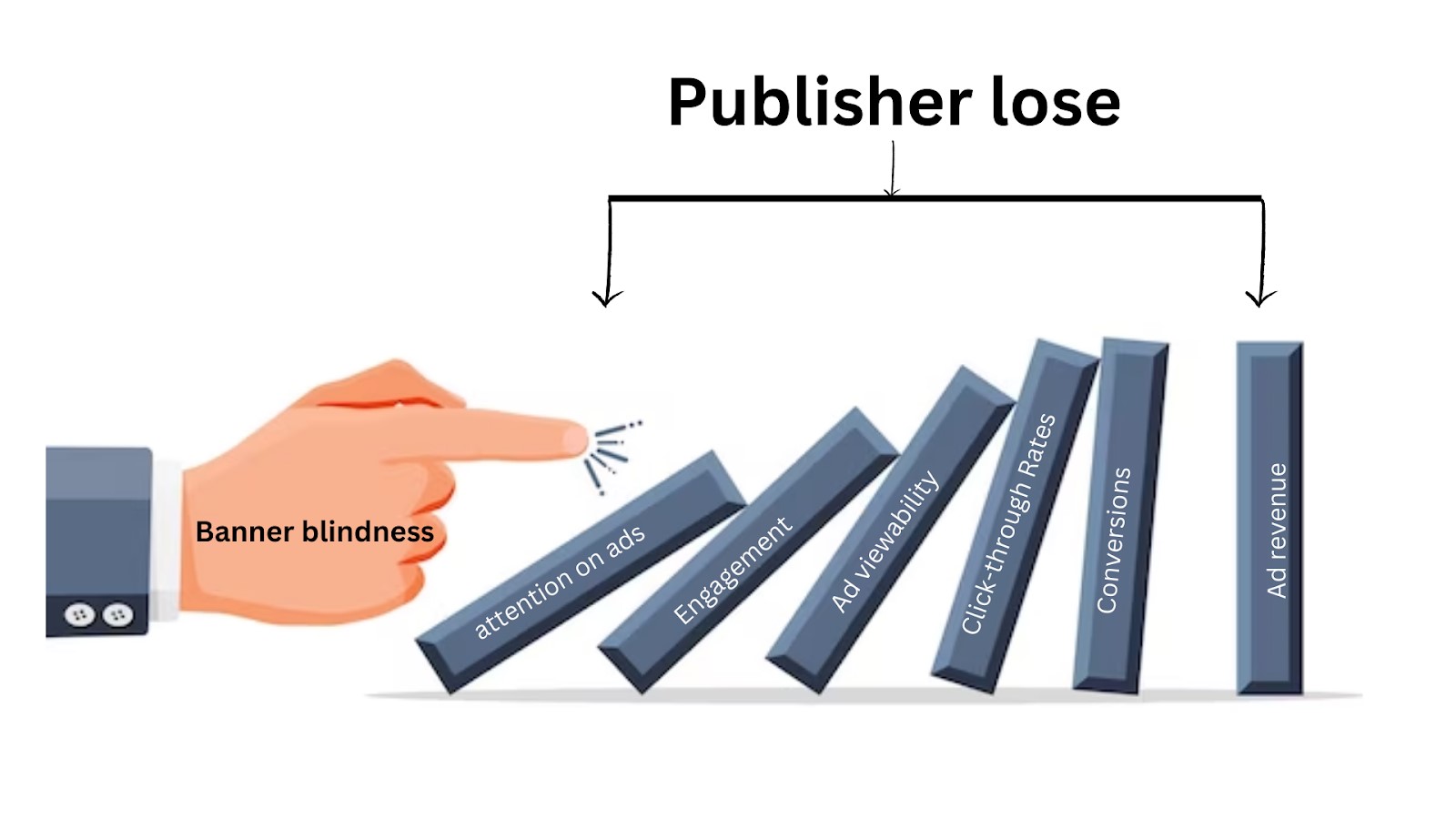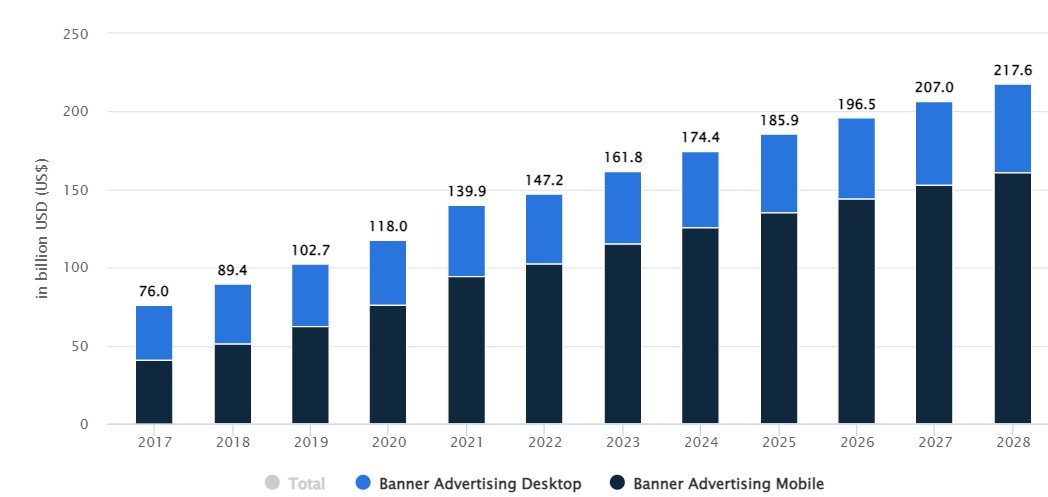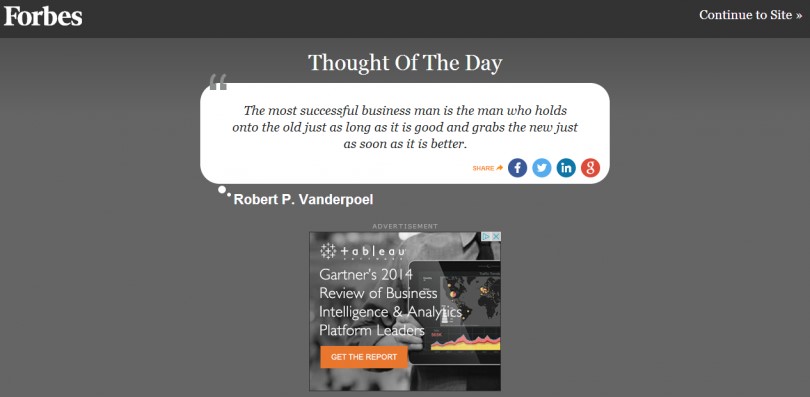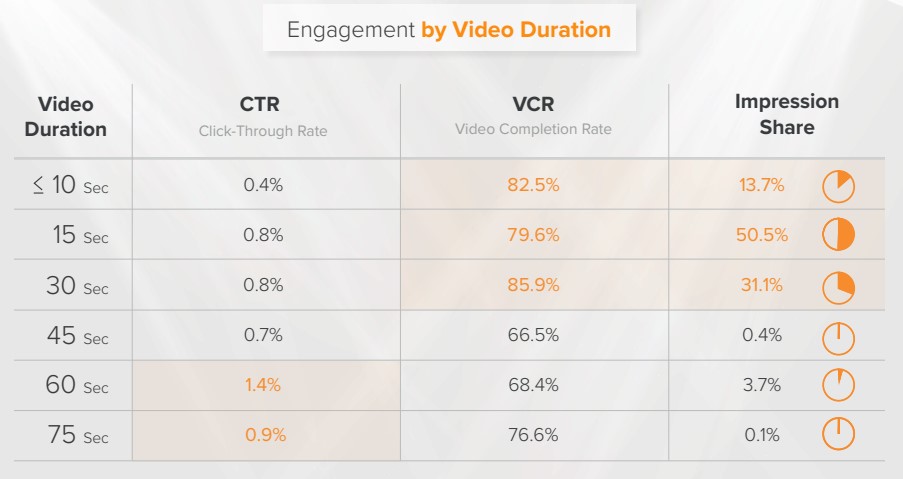As a publisher, do you remember the last banner ad that caught your attention?
No! Right?
That is the same issue with your users.
Banner ads are traditional ad formats. They are non-intrusive and ingrained largely in the digital landscape, becoming unnoticed like trees you pass on your road trip. Therefore, the phenomenon called banner blindness was born. It is an unspoken problem dealt with by both publishers and advertisers.
Banner blindness has been here for a long time. The happy news is that you can reduce it with the correct optimization measures.
This blog curates the right approaches to overcome banner blindness with correct insights and factual information. So, look no further.
Before going into the strategies, let’s see how banner blindness affects publishers.
Table of Contents
How Does Banner Blindness Affect Publishers?
Banner blindness was coined in 1998 as a result of a website usability test based on an eye-tracking experiment.
The test results say that banner ads are overlooked, and readers find them annoying and worthless. The ads that are not getting any attention will not give any better output. Here are some banner blindness statistics that reflect the statement:
- The typical internet user is served 1,707 banner ads per month, but the click-through rate (CTR) of these ads is 0.1%.
- Mobile banner ads get clicks, but 50% of them are accidental.
- The probability of banner ads getting clicked is less likely than you surviving the plane crash.
- 34% of users don’t trust banner ads at all.
And what is the result of this? As a publisher, you lose attention and engagement on ads. Eventually, the CTR and ad revenue will decrease like a domino effect.

Overall, the statistics listed say one thing: publishers expect revenue from the most-ignored ad format in the digital landscape.
These statistics are decades old, which means that the CTR of banner ads now has to be worse than that or stay the same. And publishers should have stopped using that. But that didn’t happen; on the contrary, the ad spending on banner ads is increasing yearly. It is estimated to reach $ 174.4 billion in 2024.

Source: Statista
So, what exactly is happening here?
The truth is publishers like you are not moving away from banner ads but are trying to change how they present it.
You will find how they are using it to improve revenue going forward.
The Best Ways to Reduce Banner Blindness
Eye tracking: understand user reading patterns
It is a hard truth that people don’t read web pages from top to bottom nowadays. To be specific, they scan the articles.
According to the Nielson Norman Group, only 16% of readers read your text when they first visit your website, and the remaining 79% scan the content for the information they intend to get and leave.
So, in this accord, it is important for you to understand your readers’ reading pattern, more specifically, the scanning pattern.
Nielsen Norman Group has paved the way and found the four basic reading patterns of the users from their research. The names are the F-pattern, Spotted pattern, Layer-cake pattern, and Commitment pattern.
F-pattern: As the name says, readers will scan the page in a F-pattern. First, they will scan the top of the page from left to right and skip to the middle to scan from left to right. Finally, they will scan the left side of the website from top to bottom. The f-pattern is the most common pattern that users tend to follow.

Source: Nielsen Norman Group
Spotted pattern: This pattern was derived depending on the user’s intent to find specific information like links, digits, bolded words, etc.
For example, check the heatmap result of a Wikipedia page where readers were more focused on finding the Baryshnikov education.
![]()
Layer cake pattern: The user scans the headings and subheadings of the site and leaves the content around them.
Commitment pattern: This is a traditional pattern where users read the content of the page one by one in a left to right pattern.
You know conventional ad placement reduces your Click-through Rates (CTR) and, therefore, the ad revenue. These patterns give us a whole new view of how people skim through a web page and give insights to find better ad placement spots. Also, to find the location that you can avoid.
The natural reading path is the ideal location that will get your ad noticed amid various reading patterns. You can place ads within content or at the end of the paragraph to get the user’s attention, like Bloomberg and Forbes. Ads should be placed at the natural transition level not to hurt user experience.

Source: Forbes (the ads are placed in-between the paragraphs, i.e., natural reading path)
Moreover, rather than choosing ad placement based on the already derived pattern, find your website users’ interaction pattern. Place ads accordingly to get better results, like high CTR and higher ad yield.
Unconventional ad placement
According to the study by Infolink, simple ads placed at an unconventional location that are non-intrusive attract more attention than flashy ads. A simple example of this ad is the welcome page ad.
Thought leaders like Forbes and Atlantic use welcome page ads. It welcomes readers with the “quote for the day” and a typical banner ad below it. This will get promising attention and impression when served only once to a user per day.

The other unconventional ad placement location by the Infolink study is the middle of the page. It was seen 225% quicker than standard leaderboard ads. Also, placing ads on the left side of the page instead of the right gets attention from 73% of the users.
Improve ad responsiveness across devices
Today, the U.S. programmatic display ad spend on mobile is $94 billion out of $133 billion total display ad spend. This data stresses the need to work on ad responsiveness.
Also, the primary effect of banner blindness is low CTR. You can overcome that with responsive ads. According to the Sizmek survey, the CTR is high in expandable and polite mobile banners, which is 0.63% and 0.28%, respectively. The CTR of standard mobile banner ads is around 0.09%, which is still higher than desktop ads.
High responsiveness eliminates the negative impacts of banner blindness. Therefore, mobile-first strategies are important to improve CTRs and get higher ad revenue.
Use interactive ads
Improve the performance of the static banner ads by including dynamic and interactive elements.
Interactive ads with rich media are highly likely to get attention from the users, resulting in higher engagement and CTR.
A few examples of interactive ads include
- Short video ads with high video quality and interactive elements
- Playable ads
- 3D ads
- Augmented reality ads.
The CTR of rich media ads is higher in the range of 0.30 to 1.50%, which is higher than the CTR of traditional banner ads. Further, the CTR of rich media ads stays in this range depending on the creativity and relevance.
Try video ads
Video ad spending is skyrocketing every year due to the factors that users highly prefer. Therefore, it is giving better outcomes.
They are dynamic, infused with interactive elements, and catchy enough to get the user’s attention, alleviating the banner blindness.
According to the IAB benchmark report, video ads have a higher engagement rate across different video ad formats and devices.

The CTR is also high and varies depending on the video duration. The 60-second video ads have a high CTR of 1.4%, whereas the videos below 30 seconds have a higher video completion rate and impression share.

Contextual targeting ads
Contextual targeting is another best way to reduce banner blindness by showing ads related to the page’s content. It amplifies relevancy, increasing the chance of getting the user’s attention to increase conversions and ad revenue.
The majority, 79% of consumers, exhibit a higher level of comfort in seeing contextual ads, and they have a higher likelihood of getting clicked, which is 50%. Also, the conversion rate of contextual ads is 30% higher than non-contextual ads.
Above all, we will lose cookies soon enough; contextual targeting will serve as the best cookie alternative. Hence, it also has a high scope in the future digital landscape.
Test, Iterate, and Repeat
Last but not least, whatever strategy you choose, it is better to check the performance of each strategy through rigorous testing.
Do A/B testing on every change you make on your website to check which actually performs well and which does not. You can collect useful insight on new ad placement, formats, sizes, and targeting techniques.
This helps improve the worked part and replace the unreliable ones. And this optimization and testing process is a consistent journey. You must follow regularly to keep your website the most user-loved and attract potential advertisers.
Fight Blindness, Improve Conversions and Revenue
Bring back your revenue uplift on banner ads with portrayed strategies!
The tactics listed are tried and tested by the best. And they are suggested because those approaches resonate more with your readers.
But saying is easier than done! And I believe you know that.
Implementing complex strategies and overcoming technical difficulties to reduce banner blindness takes immense wisdom and expertise. It is not handy unless you have the best ad operations professionals in your team.
Contact us if you are searching for a talented ad operation team who can do full ad management.
We are open to helping and connecting you with the best programmatic partners who give customized solutions. Because they know every publisher is different.























